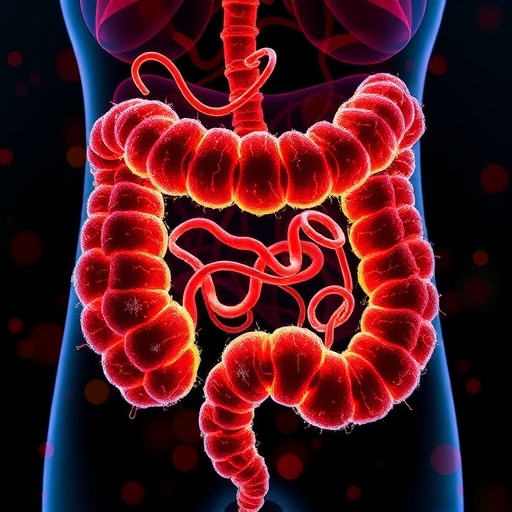In a groundbreaking study poised to redefine our understanding of nutrient-immune-stem cell interactions, researchers have uncovered how dietary cysteine acts as a pivotal modulator of intestinal stem cell (ISC) function. This revelation not only elucidates how a single semi-essential amino acid profoundly influences tissue regeneration but also highlights an intricate crosstalk between metabolism and immune signaling that could offer new therapeutic avenues for intestinal injuries.
The small intestine, recognized for its rapid cellular turnover driven by LGR5-positive intestinal stem cells, has long been a subject of intense investigation. These ISCs are known to respond dynamically to dietary macronutrient variations, including fasting and high-fat diets. Yet, the specific roles played by individual amino acids—especially cysteine—have remained elusive. Now, the latest research uncovers how cysteine metabolism intricately supports the regenerative machinery of ISCs in response to injury.
At the heart of this discovery lies cysteine’s contribution to the biosynthesis of coenzyme A (CoA), a central metabolic cofactor. Once metabolized within intestinal epithelial cells, cysteine-derived CoA sets off a cascade of events that culminate in the expansion of intraepithelial CD8αβ⁺ T cells. These immune cells, previously appreciated mainly for their cytotoxic functions, reveal a new role as orchestrators of intestinal repair by producing the cytokine interleukin-22 (IL-22).
IL-22 has been recognized as a vital factor in gut homeostasis, supporting barrier function and promoting epithelial proliferation. The study demonstrates that enhanced IL-22 signaling directly empowers ISCs to mount an effective reparative response following injury. This positions IL-22 not merely as an immune modulator but as an essential enhancer of stem cell-mediated tissue regeneration.
Mechanistic validation of this pathway was thorough and definitive. Supplementation with CoA alone mimicked the regenerative effects seen with cysteine, confirming the metabolite’s central role. Conversely, genetic ablation of the cystine transporter SLC7A11 in intestinal epithelium prevented the cysteine-induced regeneration, firmly establishing the necessity of cysteine uptake. Equally compelling, mice lacking IL-22 in their CD8αβ⁺ T cells or those depleted of these T cells entirely failed to show intestinal repair despite cysteine supplementation, highlighting the indispensable role of this immune-stem cell axis.
These pioneering findings also shed light on the concept of metabolic coupling between intestinal stem cells and resident immune cells. Traditionally studied as separate compartments, ISCs and CD8⁺ T cells here appear to engage in a metabolic dialogue where cysteine metabolism in epithelial cells enhances the immune microenvironment, which in turn influences stemness and regenerative potential. This interplay challenges previous models which considered metabolic and immune components independently in intestinal biology.
Beyond advancing fundamental physiological knowledge, this research holds considerable translational promise. Intestinal damage from conditions such as inflammatory bowel disease, chemotherapy-induced mucositis, or infection often leads to compromised barrier integrity and chronic injury. By harnessing a dietary means—essentially cysteine supplementation—to elevate stem cell function via immune modulation, the study opens the door to novel nutritional or pharmacological strategies to boost gut repair and resilience.
Moreover, the insight into SLC7A11’s involvement marks it as a potential therapeutic target. Modulating this cystine transporter could regulate cysteine levels within the intestine, fine-tuning regenerative responses for optimal tissue healing. The findings also call for revisiting dietary amino acid intake recommendations, particularly in clinical contexts where enhanced tissue regeneration is needed.
The discovery also aligns with the broader scientific narrative emphasizing the powerful role of amino acid metabolism in regulating stem cell fate and tissue homeostasis. Previous work linked fasting, high-fat diets, and ketone bodies to ISC function, but the detailed mechanism connecting a single amino acid to immune-mediated stemness was missing until now. This study elegantly fills that knowledge gap.
Importantly, the research underscores IL-22’s role beyond immune defense, portraying it as a bridge between metabolic inputs and epithelial regeneration. Future investigations could explore whether other immune-derived factors are similarly regulated by nutrient availability and whether analogous systems exist in other rapidly renewing tissues.
While the therapeutic implications are promising, careful consideration of cysteine metabolism’s systemic effects is warranted. Cysteine is known to participate in redox balance, glutathione synthesis, and other metabolic pathways. Thus, systemic modulation could have broad consequences requiring dosage and delivery strategies optimized for safety and efficacy.
Finally, the study invigorates the concept of nutritionally guided precision medicine. By delineating how dietary components directly influence stem cell biology through immune cell intermediaries, the research champions an integrated view of diet, metabolism, immunity, and regeneration. Such holistic comprehension could revolutionize treatments for gastrointestinal disorders and beyond.
In summary, this groundbreaking work reveals dietary cysteine as a crucial enhancer of ISC-mediated intestinal regeneration via a metabolic-immune axis involving CoA biosynthesis and CD8αβ⁺ T cell-derived IL-22. It bridges fundamental biology with clinical potential, offering a fresh perspective on the power of diet to influence tissue repair through cellular crosstalk. As the research community delves deeper into these mechanisms, the promise of harnessing nutrient-immunity interplay to promote health and recovery shines brighter than ever.
Subject of Research: Intestinal stem cell function and regeneration mediated by dietary cysteine and immune cell interaction
Article Title: Dietary cysteine enhances intestinal stemness via CD8⁺ T cell-derived IL-22
Article References:
Chi, F., Zhang, Q., Shay, J.E.S. et al. Dietary cysteine enhances intestinal stemness via CD8⁺ T cell-derived IL-22. Nature (2025). https://doi.org/10.1038/s41586-025-09589-5
Image Credits: AI Generated
Tags: coenzyme A biosynthesiscysteine and gut stem cellscysteine metabolism and immunitycytokines in intestinal repairdietary amino acids and immune signalingimmune modulation in gut healthintestinal injury recovery mechanismsintestinal stem cell functionLGR5-positive stem cellsmetabolism and tissue regenerationnutrient-immune interactionstherapeutic strategies for gut health





